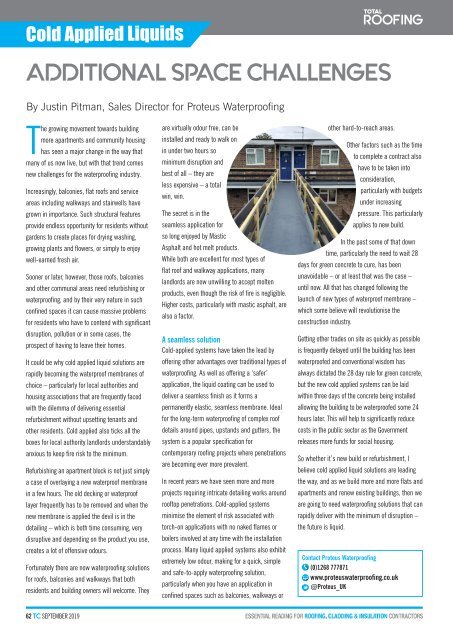September 2019
Create successful ePaper yourself
Turn your PDF publications into a flip-book with our unique Google optimized e-Paper software.
Cold Applied Liquids<br />
ADDITIONAL SPACE CHALLENGES<br />
By Justin Pitman, Sales Director for Proteus Waterproofing<br />
The growing movement towards building<br />
more apartments and community housing<br />
has seen a major change in the way that<br />
many of us now live, but with that trend comes<br />
new challenges for the waterproofing industry.<br />
Increasingly, balconies, flat roofs and service<br />
areas including walkways and stairwells have<br />
grown in importance. Such structural features<br />
provide endless opportunity for residents without<br />
gardens to create places for drying washing,<br />
growing plants and flowers, or simply to enjoy<br />
well-earned fresh air.<br />
Sooner or later, however, those roofs, balconies<br />
and other communal areas need refurbishing or<br />
waterproofing, and by their very nature in such<br />
confined spaces it can cause massive problems<br />
for residents who have to contend with significant<br />
disruption, pollution or in some cases, the<br />
prospect of having to leave their homes.<br />
It could be why cold applied liquid solutions are<br />
rapidly becoming the waterproof membranes of<br />
choice – particularly for local authorities and<br />
housing associations that are frequently faced<br />
with the dilemma of delivering essential<br />
refurbishment without upsetting tenants and<br />
other residents. Cold applied also ticks all the<br />
boxes for local authority landlords understandably<br />
anxious to keep fire risk to the minimum.<br />
Refurbishing an apartment block is not just simply<br />
a case of overlaying a new waterproof membrane<br />
in a few hours. The old decking or waterproof<br />
layer frequently has to be removed and when the<br />
new membrane is applied the devil is in the<br />
detailing – which is both time consuming, very<br />
disruptive and depending on the product you use,<br />
creates a lot of offensive odours.<br />
Fortunately there are now waterproofing solutions<br />
for roofs, balconies and walkways that both<br />
residents and building owners will welcome. They<br />
are virtually odour free, can be<br />
installed and ready to walk on<br />
in under two hours so<br />
minimum disruption and<br />
best of all – they are<br />
less expensive – a total<br />
win, win.<br />
The secret is in the<br />
seamless application for<br />
so long enjoyed by Mastic<br />
Asphalt and hot melt products.<br />
While both are excellent for most types of<br />
flat roof and walkway applications, many<br />
landlords are now unwilling to accept molten<br />
products, even though the risk of fire is negligible.<br />
Higher costs, particularly with mastic asphalt, are<br />
also a factor.<br />
A seamless solution<br />
Cold-applied systems have taken the lead by<br />
offering other advantages over traditional types of<br />
waterproofing. As well as offering a ‘safer’<br />
application, the liquid coating can be used to<br />
deliver a seamless finish as it forms a<br />
permanently elastic, seamless membrane. Ideal<br />
for the long-term waterproofing of complex roof<br />
details around pipes, upstands and gutters, the<br />
system is a popular specification for<br />
contemporary roofing projects where penetrations<br />
are becoming ever more prevalent.<br />
In recent years we have seen more and more<br />
projects requiring intricate detailing works around<br />
rooftop penetrations. Cold-applied systems<br />
minimise the element of risk associated with<br />
torch-on applications with no naked flames or<br />
boilers involved at any time with the installation<br />
process. Many liquid applied systems also exhibit<br />
extremely low odour, making for a quick, simple<br />
and safe-to-apply waterproofing solution,<br />
particularly when you have an application in<br />
confined spaces such as balconies, walkways or<br />
other hard-to-reach areas.<br />
Other factors such as the time<br />
to complete a contract also<br />
have to be taken into<br />
consideration,<br />
particularly with budgets<br />
under increasing<br />
pressure. This particularly<br />
applies to new build.<br />
In the past some of that down<br />
time, particularly the need to wait 28<br />
days for green concrete to cure, has been<br />
unavoidable – or at least that was the case –<br />
until now. All that has changed following the<br />
launch of new types of waterproof membrane –<br />
which some believe will revolutionise the<br />
construction industry.<br />
Getting other trades on site as quickly as possible<br />
is frequently delayed until the building has been<br />
waterproofed and conventional wisdom has<br />
always dictated the 28 day rule for green concrete,<br />
but the new cold applied systems can be laid<br />
within three days of the concrete being installed<br />
allowing the building to be waterproofed some 24<br />
hours later. This will help to significantly reduce<br />
costs in the public sector as the Government<br />
releases more funds for social housing.<br />
So whether it’s new build or refurbishment, I<br />
believe cold applied liquid solutions are leading<br />
the way, and as we build more and more flats and<br />
apartments and renew existing buildings, then we<br />
are going to need waterproofing solutions that can<br />
rapidly deliver with the minimum of disruption –<br />
the future is liquid.<br />
Contact Proteus Waterproofing<br />
(0)1268 777871<br />
www.proteuswaterproofing.co.uk<br />
@Proteus_UK<br />
62 TC SEPTEMBER <strong>2019</strong>

















